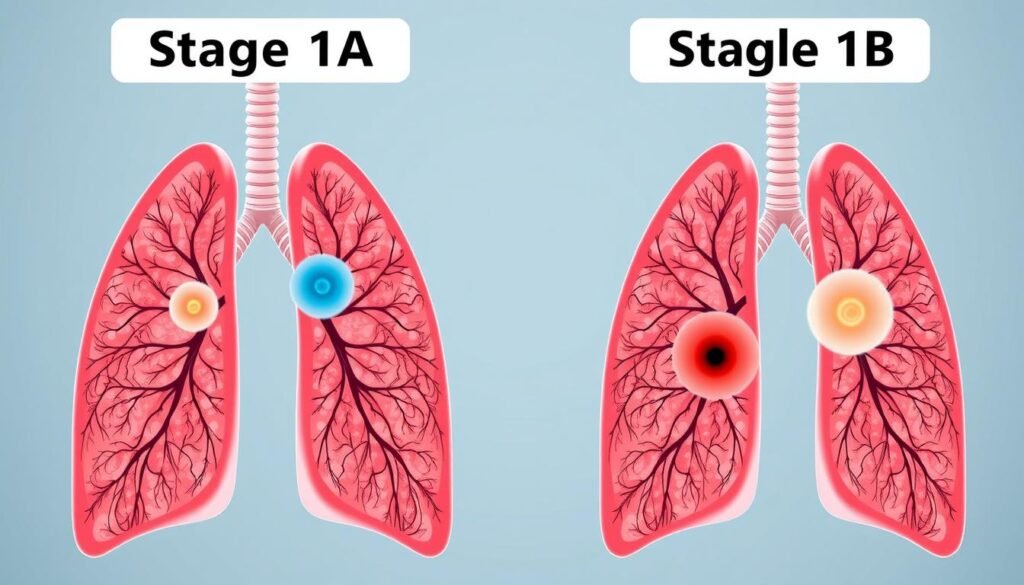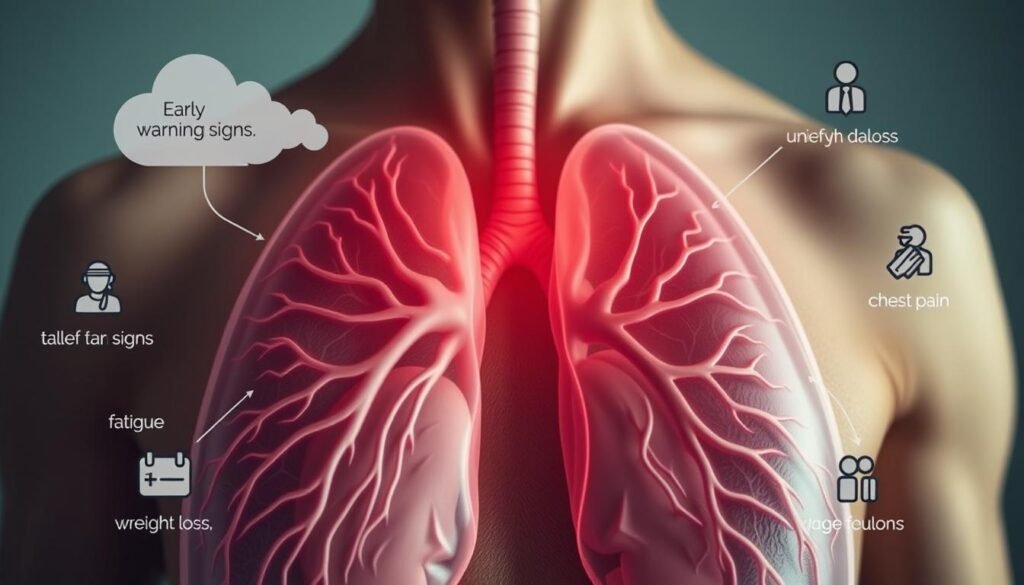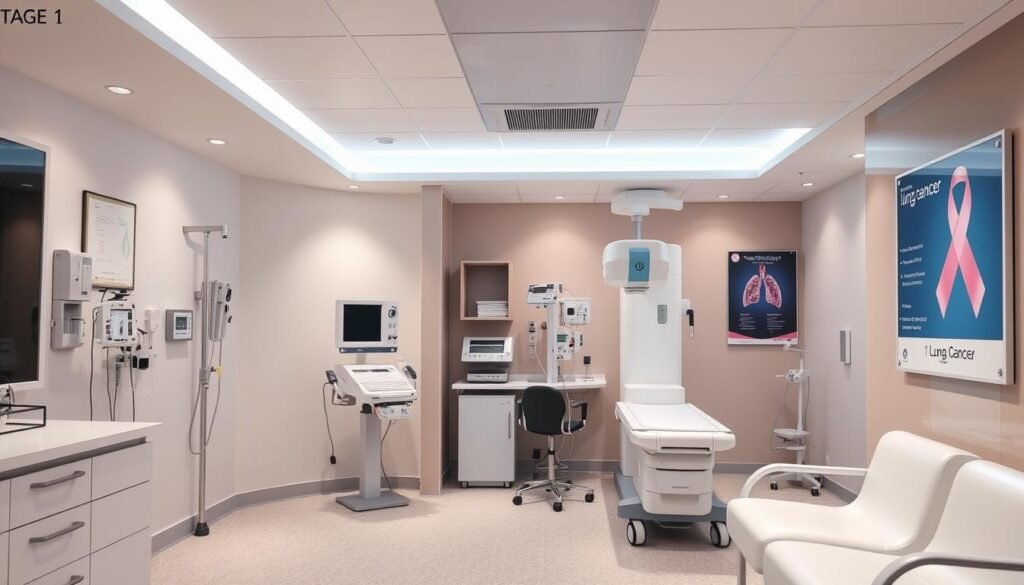Lung cancer is the top cause of cancer deaths around the world. It is responsible for almost 1 in 5 cancer deaths. Stage 1 non-small cell lung cancer is divided into groups based on the tumor size. Knowing the early signs of lung cancer can greatly improve patient outcomes. At the start, many people do not show symptoms. This makes it important to notice the small signs that could mean a big health issue. Knowing the signs of advanced lung cancer in Stage 1 helps people get medical help early. This increases their chances of successful treatment.
Lasting coughs, feeling short of breath, and losing weight without trying can signal lung cancer. Finding these symptoms early is key. It leads to a better outcome when starting treatment like surgery or targeted therapies. For more info on checking your risk for lung cancer and its symptoms, check out this resource guide.
Key Takeaways
- Lung cancer is the leading cause of cancer deaths globally, highlighting the need for awareness.
- Stage 1 lung cancer often presents no symptoms, increasing the importance of vigilance.
- Early symptoms may include persistent cough and shortness of breath, among others.
- Understanding the signs of advanced lung cancer in Stage 1 can lead to timely treatment.
- Resources are available to help identify symptoms and risks related to lung cancer.
Understanding Stage 1 Lung Cancer
Stage 1 lung cancer is the beginning of the disease, split into stage 1A and 1B. Stage 1A involves tumors under 3 centimeters only in the lungs. Stage 1B tumors are 3 to 4 centimeters and may reach nearby areas. This difference is key for planning treatments.
Non-small cell lung cancer (NSCLC) is the most common type in stage 1, making up over 87% of cases. If caught and treated early, up to 90% of these cases can be cured. The chances of living more than five years after diagnosis can be over 65% with early action.
The chances of survival change within stage 1. For instance, 92% of those with stage 1A1 live at least five years. However, this drops to 83% for stage 1A2 and 68% for stage 1B. Knowing the tumor types in stage 1 NSCLC is crucial for treatment and better survival rates.
Common Symptoms of Lung Cancer
Lung cancer comes with various indicators. Recognizing these early can help start treatments sooner. Often, symptoms are mild at first but get worse over time.
Persistent Cough
If you have a cough that doesn’t go away for over eight weeks, it could mean lung cancer. This cough can interrupt your day and lead to lung infections like bronchitis. If this happens, seeing a doctor to check the cause is crucial.
Shortness of Breath
Feeling short of breath is a sign of lung cancer, too. It happens when airways get narrow, making it hard to breathe. This can occur during activities or even when resting. It’s key to get checked by a doctor if this happens.
Coughing Up Blood
Coughing up blood is a serious warning sign. Any blood in your mucus means you need to see a doctor fast. It could point to a tumor or damage in the lung area.
Chest Pain
Chest pain is another symptom that comes with lung cancer. It can hurt when you breathe deep, cough, or laugh. This might be because the tumor is pushing against something inside your chest. Anyone with chest pain should get help right away.
Signs of Advanced Lung Cancer in Stage 1
Spotting signs of advanced lung cancer early is key in affecting the outcome of treatment. Even in Stage 1, some might notice distinct signs of advanced lung cancer. These signs should not be ignored. Increased fatigue is a typical symptom, noted by many. This fatigue makes day-to-day tasks harder than before.
Persistent infections are another major sign. Those with advanced lung cancer often catch illnesses more easily. They get frequent respiratory infections that don’t get better with common treatments. Also, the onset of wheezing should raise alarms. It suggests blocked airways or lung inflammation, which are serious issues.
Catching early lung cancer signs can lead to quick and effective treatment. Being aware of these symptoms means you can see a doctor sooner. This knowledge is crucial for catching the disease early and starting treatment quickly.
| Signs of Advanced Lung Cancer | Symptoms Description |
|---|---|
| Increased Fatigue | Persistent tiredness affecting daily activities. |
| Frequent Infections | Higher susceptibility to respiratory infections that may linger. |
| Newly Developed Wheezing | Sound produced during breathing, indicative of airway issues. |
Understanding and recognizing these signs is crucial. It encourages people to seek medical help early. Early action can lead to the right screenings and treatments for advanced lung cancer.
Distinguishing Between Stage 1A and Stage 1B Lung Cancer
It’s crucial to know the differences between stage 1A lung cancer and stage 1B lung cancer. This knowledge helps doctors plan the best treatment. Stage 1A lung cancer means the tumor is small, 3 cm or less, and hasn’t spread.
Stage 1B lung cancer, on the other hand, involves bigger tumors. They are 3 cm to 4 cm or have spread to nearby areas but not to lymph nodes. Knowing the exact stage helps doctors choose the best treatment, which can improve survival rates.

The specifics of the tumor play a big role in deciding how to treat it. For example, treatment varies depending on if the cancer is stage 1A or 1B. The size of the tumor and whether it affects nearby areas are key factors.
| Sub-stage | Tumor Size | Lymph Node Involvement | Characteristics |
|---|---|---|---|
| Stage 1A | Up to 3 cm | No | Localized tumor, confined to the lung |
| Stage 1B | 3-4 cm | No | Localized tumor with invasion into nearby structures |
For more on lung cancer stages and symptoms, visit this page. It has lots of useful information.
Importance of Early Detection
Finding lung cancer early is key to better treatment results and longer life. Lung cancer is the second most common cancer in the US and leads to many deaths. Knowing early signs and understanding screening advice can help. It helps people take action for their health.
Screening Recommendations
The American Cancer Society suggests that people 50 to 80 years old who smoked a lot get checked every year. They should have a specific type of scan called LDCT. This can find lung cancer early, which is easier to treat. It’s important to talk to your doctor about these checks.
LDCT scans are good at finding early lung cancer but might miss some or give false alarms. Go to places that specialize in LDCT scans. They can give the right care if needed. Being proactive improves treatment success.
Reducing Risk Factors
To prevent lung cancer, it’s crucial to lower risks. Stopping smoking is one of the best ways. Eating well and exercising also help keep your lungs healthy. If you’ve smoked before, getting help to quit can cut your cancer risk.
Talking to doctors about screening and your health is important. This teamwork can help find lung cancer early. That can make survival more likely.
| Screening Age | Smoking History | Recommended Action |
|---|---|---|
| 50-80 years | 20 pack-years or more | Yearly LDCT screening |
| Current or former smoker | Quit within the past 15 years | Yearly LDCT screening |
| Less than 50 years | Less than 20 pack-years | No screening recommended |
Talking often about screening for lung cancer is key. For more on how early detection links to your health, visit this article.
Other Symptoms Not to Ignore
Some lung cancer symptoms may not grab your attention but are key signs. Spotting these symptoms early can lead to quicker diagnosis.
Hoarseness
Hoarseness isn’t just annoying; it might suggest lung cancer. If a tumor presses on the vocal cords or throat areas, hoarseness occurs. Anyone with lasting hoarseness should get checked to rule out serious conditions.
Unexplained Weight Loss
Losing ten or more pounds without trying can be alarming. It’s often a sign of big health problems like cancer. If your weight drops suddenly without diet or exercise changes, it could mean lung cancer. A detailed check-up is crucial.

Knowing lung cancer symptoms and the value of finding them early is vital. For more on unexpected signs, check out insights like this article. It talks about early warning signs you shouldn’t miss.
Lung Cancer Diagnosis Process
Understanding how doctors diagnose lung cancer is crucial. It helps with quick action and effective treatment. The first step is usually a chest X-ray. This test is important but it can’t always tell if it’s cancer or another issue.
Next, a CT scan often follows. This scan takes pictures of your lungs in detail, thanks to a contrast medium. It lasts between 10 to 30 minutes. Doctors review these images to spot any strange changes.
After that, a PET-CT scan might be done to check the suspicious areas more closely. It identifies active cancer cells, assisting in planning the treatment. This procedure can take from 30 to 60 minutes.
If these scans show signs of cancer, a deeper look might be needed. Methods like bronchoscopy and biopsy collect cell samples. Then, these samples are examined to confirm if it’s cancer.
The stage of the cancer is crucial to know. For a common type, like non-small-cell lung cancer, doctors use the TNM system. This tells them about the tumor’s size, if it’s spread to lymph nodes, or elsewhere. Knowing the stage helps decide on treatment.
In short, diagnosing lung cancer involves different tests. These tests are key for catching the disease early. And early detection increases the chances of successful treatment.
Treatment Options for Stage 1 Lung Cancer
For stage 1 lung cancer, treatments aim for the best outcomes through different methods. Surgery is often the first step, chosen based on the tumor’s type and location and the patient’s health. This early stage offers many treatment options to manage the disease well.
Surgical Procedures
Surgery is key for treating stage 1 non-small cell lung cancer in those healthy enough for it. Removing the lung lobe with the tumor through a lobectomy is common. It’s the top method for fully getting rid of the cancer. If lung function is weak, smaller sections of the lung might be removed instead.
When surgery happens, lymph nodes are removed and checked to see if cancer has spread. If surgery isn’t possible, radiation therapy like SBRT could be used, especially if the cancer is still inside the lungs.
Targeted Therapy and Chemotherapy
After surgery, chemotherapy may help stage 1B non-small cell lung cancer patients live longer. It works to kill any leftover cancer cells. The main chemotherapy drugs are cisplatin and vinorelbine, with options like carboplatin and paclitaxel for those who can’t handle cisplatin.
There’s also immunotherapy, for example, atezolizumab (Tecentriq), for some stage 1 patients after surgery. Looking into clinical trials can provide access to new ways of preventing, diagnosing, and treating lung cancer, enhancing tailored care.

Prognosis and Survival Rates for Stage 1 Lung Cancer
The outlook for stage 1 lung cancer is positive, especially for those with localized non-small cell lung cancer (NSCLC). About 65% of these patients can expect to live five years after diagnosis. This shows a positive future for those who find and treat it early.
Survival rates can vary a lot. The type of cancer makes a big difference. While NSCLC has better survival rates, small cell lung cancer (SCLC) has a lower five-year rate of about 30% for localized cases. Things like genetic makeup, age, and overall health also play a huge role.
New treatments are making a big difference in survival rates. Patients today often do better than those treated years ago. The SEER database shows how important early detection is:
| Cancer Type | Localized Survival Rate | Regional Survival Rate | Distant Survival Rate | Overall Survival Rate |
|---|---|---|---|---|
| Non-Small Cell Lung Cancer (NSCLC) | 65% | 37% | 9% | 28% |
| Small Cell Lung Cancer (SCLC) | 30% | 18% | 3% | 7% |
Knowing these rates is crucial for patients and doctors alike. Sadly, less than 20% of lung cancer patients survive five years after finding out they have it. Yet, there’s hope. New treatments are showing promise for those diagnosed with stage 1 lung cancer.
Conclusion
Knowing the early signs of lung cancer when it’s just starting is super important. Symptoms like a bad cough or losing weight without trying tell us we should see a doctor. Finding it early can make treatments work better and help people live longer.
Lung cancer is the top cause of cancer deaths in the USA. This is why it’s key for doctors and everyone else to keep lungs healthy. Places like the American Lung Association suggest regular checks to find lung cancer soon. Early discovery means people have a better shot at beating the disease.
Creating awareness about lung cancer symptoms and risks leads to a healthier community. When people are well-informed, they can look after their lung health better. This increases the chances of living longer. It all starts with knowing what signs to look for and getting help right away.